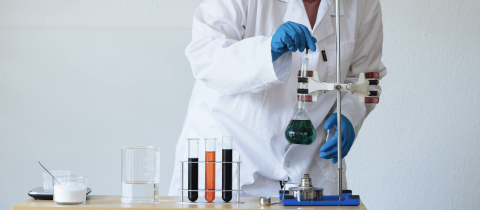Physicians today are unlikely to encounter “Gilder’s palsy.” But prior to the 19th century this ailment had to be considered when a patient presented with tremors, irritability, increased salivation and fatigue. The culprit was mercury. And the patient may very well have been a “gilder.”
Mercury’s toxicity is a consequence of its ready binding to sulphur, an element that is a crucial component of many enzymes. Some of these enzymes are critical to the workings of the central nervous system and their failure to function properly when bound to mercury causes the shakes and mental disturbances that are characteristic of mercury poisoning. Gilders, whose profession was based on coating metal objects with gold, exhibited such symptoms. Their problems came from exposure to metallic mercury, the silvery liquid found in thermometers. The Romans called the metal hydrargyrum, meaning “liquid silver,” which also explains why we use the symbol Hg for the element. Liquid mercury is somewhat volatile and can therefore be inhaled and absorbed into the bloodstream from the lungs.
Metallic mercury does not occur in nature, but it can be produced by heating cinnabar, a naturally occurring form of mercury sulphide (HgS). The metal has long fascinated people, especially the alchemists who thought that it was the key to the transmutation of base metals into gold. Of course it was not that, but there is a gold connection. Gold readily forms an alloy with mercury, a phenomenon that is apparent to anyone who has handled mercury while wearing a gold ring. While playing with mercury is a bad idea, the historical alloying with mercury to form “gold amalgam” has been an important method for isolating gold from ores. The traditional process involves crushing the gold ore, mixing it with mercury and separating the amalgam that forms. This is then heated to drive off the volatile mercury, leaving pure gold behind. But it can leave something else behind as well. The misery of mercury poisoning! And many a button gilder could have testified to that.
Military uniforms commonly feature golden buttons. Until about the middle 1800s these were made by dipping metal buttons into gold amalgam and then heating to evaporate the mercury. The layer of gold left behind was very thin, just one gram of gold was enough to gild about 500 buttons. The results for the buttons were pretty, but for humans, not so much. On occasion, even construction workers had to deal with “gilder’s palsy.” About 100 kilos of gold were mixed with mercury for application to the copper sheets that were used to create the golden dome that adorns the cathedral of St. Isaac in St. Petersburg. The dome, unfortunately, is also a symbol of mercury poisoning. Some sixty workers died as a result of mercury inhalation! However, the chemical ingenuity of two Italians would eventually put gilder’s palsy on the back burner.
In 1800, Allesandro Volta’s discovery of an electric current flowing between two dissimilar metals separated by moistened cardboard established the chemical principles that would lead to the first battery. Just five years later his friend, Luigi Brugnatelli reported in Belgian Journal of Physics and Chemistry how he had put the “Voltaic pile” to use: "I have lately gilt in a complete manner two large silver medals, by bringing them into communication by means of a steel wire, with a negative pole of a voltaic pile, and keeping them one after the other immersed in “ammoniuret of gold” (gold dissolved in an ammonia solution) newly made and well saturated." Brugnatelli had discovered electroplating, a process that would be commercialized by Henry and George Elkington of Birmingham, England in 1840. That put an end to gilder’s palsy.







